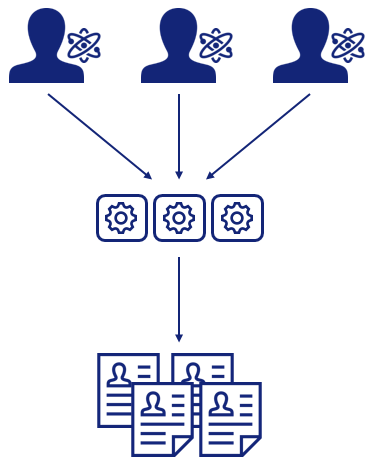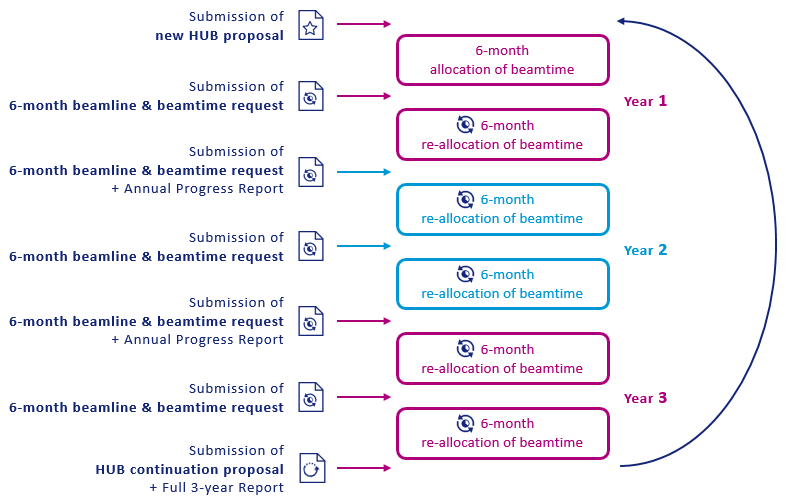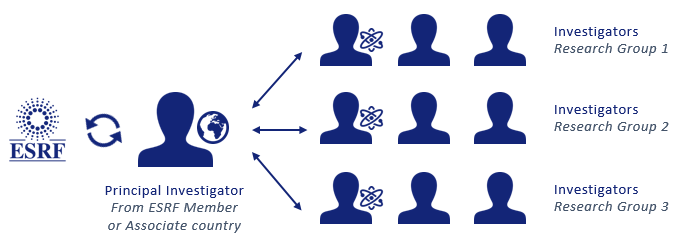HUB Proposals
A HUB proposal is a community access proposal grouping together a number of independent Principal Investigators (PIs) working in the same major scientific field of high societal relevance, who commit to collaborate to coordinate the beamtime use and share results obtained in such a way that progress is faster and more impactful across the field.
| This necessitates that the HUB members share knowledge, technology, beamtime data and results prior to publication. |
The aim is to create a hub of researchers of differing expertise working in the same major scientific field, who are willing to collaborate in order to produce greater advances and more impactful science in a shorter time frame.
If successful, the ESRF will grant beamtime to the HUB and the applicants will decide themselves how best to distribute the beamtime within the community and for the different projects.
HUB proposals may be submitted once a year, for the deadline of 15th January, starting from 15th January 2023.
Specific topical “calls” for HUB proposals are not foreseen. HUB proposals should develop naturally and organically through exchange between the user community and the ESRF management and relevant beamline scientists. The ESRF provides an opportunity for accelerated R&D in a field of high societal relevance via the HUB proposal, but it does not initiate such activity in a particular field.
Beamline and beamtime request: should normally be limited to a maximum of 18 shifts per 6-month allocation period on each of the beamlines required, with the request limited to a maximum of 6 beamlines (each responding to a specific need).
| The proposal will undergo two peer-reviews and the final decision on approval will be taken by a sub-committee of the ESRF scientific advisory committee (SAC). | |
| If accepted, the HUB will be awarded beamtime for a 3-year period. | |
| At each 6-monthly proposal submission deadline, the HUB must submit a “6-month beamline and beamtime request”, clarifying the beamtime request and the experiments to be carried out in the 6 months to come. | |
| A HUB continuation proposal must be submitted after 3 years if the HUB wishes to continue its activity. |
Reporting and evaluation will be made on a yearly basis via annual progress reports. The reports need to clearly demonstrate that the HUB represents significant added value as compared to carrying out the same research via individual proposals.
| The creation or conception of a HUB must be discussed with the ESRF Management and the relevant beamline staff before submission of a proposal. | |
| The need, advantages and added value of the HUB mechanism over the standard access mode for the research field in question must be made clear. | |
| A formal structure (e.g. coordination or steering board) for governance and organisation of the HUB needs to be set up when the HUB is being discussed and conceived within the community. This governance structure will deal with issues such as initial and future requests to join the HUB, scientific evaluation and decisions on priority for beamtime within the HUB, the fair distribution of beamtime, etc., allowing the ESRF to easily refer any question on these issues to this structure or board. The annual progress reports will request information and updates on this aspect, e.g. any new member requests with decision to accept/reject with reasons, how beamtime distribution was managed, and a breakdown of beamtime distributed to each project/PI/study). |
If accepted, each HUB must set up web pages, with at least the front page housed on the ESRF web site following a specific minimum web page template (link coming soon). The pages should include:
| 1 | Information on the HUB: e.g. what field, what aims, beamlines used, PIs involved |
| 2 | Information for potential new PIs to join with instructions on how to apply and guidelines for conditions to join, e.g. obligation to share results and data when joining a HUB, ability to add additional knowledge, capabilities and dimensions to the HUB |
| 3 | A description of the internal mechanism for distributing beamtime. |
The decision on who can join a HUB will be made by the steering board/governance structure of the HUB and monitored by those independently reviewing the proposal and reports.
The ESRF will continue to welcome and review standard proposals in the same field from researchers who are not members of an existing HUB.
| However, standard proposals for work in the same field, that correspond to the scope of the HUB and request the same beamlines, may not be submitted by researchers who are part of an existing HUB – the work should be discussed and carried out within the framework of the HUB. |
Standard proposals in the same field may be submitted by HUB members for beamlines not allocated within the HUB or if the work cannot be done within the scope of the HUB (e.g. for scientific, technical or safety constraints).
To ensure and foster the collaborative and sharing aspects of a HUB, the decisions on what experiments will be done should be made together by the HUB members as a consortium strategy, and the resulting data and outcomes shared within the consortium.
The approval of a HUB proposal is based on a commitment by the HUB members to collaborate.
| This necessitates that the HUB members share knowledge, technology, beamtime data and results prior to publication. |
Concerning data sharing within a HUB: The ESRF data policy currently allows all proposers (investigators) to access all the data collected under the proposal number. The users of the different experiment sessions have access to the data collected during the experiment session they participated in. The data are not accessible outside of this group during the 3-year embargo period, after which time they will become public according to the ESRF data policy. During the embargo period, the sharing of data with persons outside of this group and the management of additional access rights to third persons is the responsibility of the HUB Principal Investigator, as for all ESRF public proposals.
As for all ESRF proposals, each HUB must be identified with a single spokesperson, who is named as Principal Investigator, along with a list of Co-Investigators. The Principal Investigator must be affiliated to a scientific institution of an ESRF Member or Associate country. Exceptions from this provision require prior agreement from the ESRF Management.
The list of investigators must comprise at least 3 independent research groups, and may include groups from outside the ESRF Member or Associate countries. An ESRF scientist may participate as one of the scientific investigators in a HUB, but not as its Principal Investigator, as long as he/she is directly scientifically involved in the HUB research. It is not mandatory for an ESRF staff member to be part of a HUB, this is not one of the acceptance criteria.
The Principal Investigator is the single contact point for the ESRF and is responsible for submitting:
- The HUB proposal
- The 6-month beamline and beamtime requests
- The A-Forms
- The HUB annual reports
 Scientific Review
Scientific Review
The science and impact evaluation are made by an ad hoc panel of 3-5 scientific experts in the specific field, composed of relevant members of the current Beam Time Allocation Panels (BTAPs) and one member of the SAC, with external experts as necessary. The criteria for evaluation are:
| 1 | Value and impact of the HUB on the field of research |
| 2 | Value and impact of the HUB in other fields |
| 3 | Societal impact |
| 4 | Expertise and competence of the Principal Investigators composing the HUB |
| 5 | Added value of the HUB mechanism as opposed to access via standard proposals |
| 6 | Quality of the proposal and associated reports |
This review is followed by an evaluation of the beamtime request and the impact on the other beamline proposals by the regular BTAPs. The BTAPs will be asked to evaluate:
| 1 | How well the research proposed in the HUB proposal fits into the overall strategy of the beamline(s) requested |
| 2 | How it might impact the activity and other proposals on that beamline |
| 3 | Whether the amount of beamtime requested is reasonable in this context |
The recommendations from both panels as well as the recommendation from the ESRF Management are submitted to the ESRF SAC, who will make a final recommendation to Management on approval of the HUB for a 3-year period.
 Technical & Safety Review
Technical & Safety Review
This is made as for the standard access mechanism by the beamline scientists for the technical review and Safety Group for the safety review.
| The initial HUB proposal submitted on 15th January includes a 6-month beamline and beamtime request form, detailing the experiments planned in the first 6 months of beamtime. A new version of this form must be submitted for each subsequent ESRF proposal deadline (10th September and 1st March), detailing the planned experiments for the next 6-months request. This, along with the initial “umbrella” proposal, will be used for the technical and safety review. | |
| As a general rule, no more than 30% of the beamtime on a single beamline should be assigned to proposals involving a long-term commitment of beamtime such as Long Term Projects (LTPs), BAGs and HUBs, in order to leave sufficient time available for regular standard proposals. Management may decide on an exceptional basis to exceed this limit as necessary. |
The success and continuing pertinence of a HUB will be assessed via annual reports that are evaluated by both the ad hoc panel and concerned BTAPs. Their assessments will be forwarded to the SAC. The annual report must be submitted by the HUB spokesperson as a pdf document to the User Office each year on or before the 31st January.
Key items in the assessment are:
| Scientific publications emerging from the HUB and their impact | |
| Major challenges and questions addressed and answered | |
| Societal impact of the HUB activity | |
| Methodologies developed | |
| Equipment / technologies developed | |
| Any external contributions such as funding obtained | |
| Good management and governance of the HUB | |
| Added value of the HUB scheme versus standard proposal applications and these must be clearly described in the report |
If the HUB members wish to continue their activity after the 3-year period, a HUB continuation proposal must be submitted.
HUB reports and continuation proposals will be evaluated along with other standard, long term, BAG and HUB proposals on the concerned beamlines. The ESRF Management reserves the right to terminate a HUB proposal if the output and governance of the HUB is evaluated as non-satisfactory, or if the HUB is evaluated as being less competitive than competing proposals on the concerned beamline(s).
| In case of failure to submit an annual report, the ESRF Management reserves the right to stop the allocation of beamtime to the HUB. Failure to submit reports may affect the acceptance of future proposals at the ESRF by the applicants concerned. |
| 1 |
|
||||||
| 2 | If the HUB proposal is approved and awarded beamtime:
|
 Templates Required
Templates Required
| 1 | |
| 2 |






